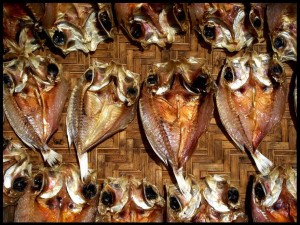So there I was watching a documentary about mediaeval armies and something caught my ear. I never realized that up to 1/3rd of a campaigning armies diet was fish. The reason for this is that it was a form of protein relatively cheap to produce and preserve. The fish were salted and typically packed into barrels. My father told me about eating salted fish and port when he was young and freezers were expensive and hard to come by. In his later years, feeling nostalgic he had purchased some old fashioned salted pork and was astounded that all he could taste was salt. For those unaccustomed to old fashioned salted meats one of the first things that will catch you off guard is how salty it tastes, you think I’m being clever but it’s true; the second will be the urine like smell when you cook or fry it.
Fish curing includes and of curing fish by drying, salting, smoking, and pickling, or by combinations of these processes have been employed since ancient times. On sailing vessels fish were usually salted down immediately to prevent spoilage. Many of these can be purchased but they cater a little more to flavor and the modern world because fridges and freezers make bacteria control much more manageable in our day. In some cultures fish are actually fermented as a preservation technique not unlike the necessity of fermenting wines with in the context of the bible for preservation; but I’ve personally avoided any kind of fermented meat thus far.
While in the Philippines I observed this ancient technique of fish preservation first hand; and yes eating it did take some getting used to, but I love it now. The fish were pulled out of the sea and the ones too small to take to market were soaked for up to several days in a strong salt water solution and then laid out one a street or sidewalk to dry and bake in the sun. The fish were flipped every few hours and taken in at night. Not only because of market value, but larger fish were also consumed fresh because it would take a much longer period for them to become saturated in the solution and then dry thoroughly; leaving them highly subject to mold and spoilage in such a warm climate. The exception in the Philippines were some medium sized fish that were cut in half and gutted; and yes the internal organs were left intact in the small fish.
The consumption of this salted fish, or bulad as the locals called it, plenty of rice and a relatively bland sauce that would complement the saltiness of the fish. Very little bulad was needed for flavoring a whole plate of rise and when it was consumed bones and head were typically consumed also.
For preparing bulad start by selecting fish any ware from 3 to 6 inches long. The locals were I lived would typically salt them for a 24 hour period in a vat of salt water solution, 2 parts water, 1 part salt. The fish would then be laid out under the hot sun to dry until they retained no moisture. I’ve seen these last months and months. To prepare fry in a pan with oil like any other fried fish. Simple enough? For Sauce recipes you would have to visit with a Filipino; and probably have them cook it so it tastes right.
Barangay Masao, Butuan City on August 11, 2012. photo by Erwin Mascarinas.
I hope any of you Filipinos, pinoy ug pinay, will correct me if I get anything wrong. And please let me know how you make the sauce with the green gabbi leaves.
Also, I’ve only seen this done with saltwater fish and I do not know if there is a difference when it comes to salting freshwater fish; let me know if you do.
Jon




Leave a Reply